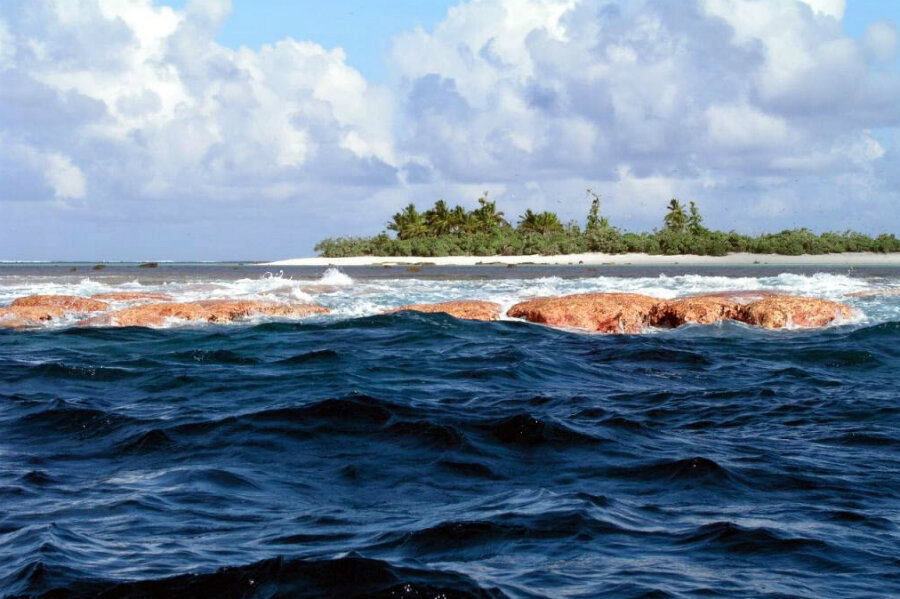Obama extends vast marine reserve in central Pacific Ocean
Loading...
Building on a legacy left by President George W. Bush, President Obama has extended the reach of the Pacific Remote Islands National Marine Monument sixfold to nearly half a million square miles, turning it into the world's largest marine sanctuary, one fully protected from commercial fishing and deep-sea mining.
The move came via a presidential proclamation Thursday, issued under the 1906 Antiquities Act. The act allows a president to set aside for preservation structures or objects of historic or scientific interest on federal lands.
In 2009, former President Bush established the monument, centered on seven islands and atolls the US administers in the central Pacific Ocean. Each island or atoll was protected out to a distance of 50 nautical miles, giving the monument an area of 83,000 square miles.
In his proclamation, Mr. Obama extended the monument's reach out to the full 200-mile limit – waters falling within US's exclusive economic zone – around three of the islands and atolls. This raises the monument's collective area to 490,000 square miles.
Had the president included the other four islands in the expansion, the monument would have covered about 780,000 square miles. But after taking into account public comments, as well as the administration's own scientific assessment, the White House concluded that the expansion that became official today represents appropriately tailored and meaningful protections, according to administration officials.
Marine-conservation specialists are elated by the move.
"We're really thrilled. It's a huge step forward for the ocean. It's going to help spur other countries to take action," says Sarah Chasis, who heads the oceans program at the National Resources Defense Council in New York.
The White House signaled its intention to expand the marine monument in June during an international conference in Washington that focused on marine conservation. Secretary of State John Kerry convened the two-day meeting to build support for more-ambitious efforts to safeguard the environmental health of the world's oceans.
The key threats include over-fishing, pollution, and rising levels of carbon dioxide (CO2) from burning fossil fuels and from land-use changes. Rising CO2 levels have triggered global warming, and the oceans have become increasingly acidic as they take up much of the CO2 humans have pumped into the atmosphere.
The impact of warming on the oceans on marine life already is appearing as warm-water species migrate northward out of their historic ecological regions. Meanwhile, acidification threatens corals and many types of shell-building marine life, and by extension, the animals higher up the food chain that rely on them, researchers say.
Fully protected reserves are more resilient in the face of these pressures than are degraded marine ecosystems, researchers say.
Under the UN Convention on Biological Diversity, countries have agreed to protect some 10 percent of the world's oceans by 2020. So far, slightly less than 2 percent has come under some form of protection. Meanwhile, many marine scientists have been arguing for 20 percent of the oceans, representing the full range of current marine ecological regions.
Expansion of the Pacific Remote Islands National Marine Monument represents a preemptive move, rather than one responding to a severely damaged set of ecosystems, researchers say.
The remote nature of the islands makes them expensive to reach, so scientists haven't been able to conduct the number and range of studies they have been able to undertake for places easier to reach, acknowledges Elliott Norse, founder and chief scientist of the Marine Conservation Institute in Seattle.
"But the science that we have from there paints an extraordinary picture," he says. The research done so far hints "at what ecosystems that are really pristine may actually be like."
For instance, few things say "pristine environment" like a healthy population of top predators. Around these islands, researchers have found that most of the fish biomass is made up of top predators, not the fish farther down the food chain. On land, top predators tend to be the least numerous. It's as though someone flipped the typical food-chain pyramid, Dr. Norse says. And these abundant predators largely seem to be locals, not migrants stopping for a bite to eat on their way through.
Beyond preserving a pristine environment, the expansion also helps retain the islands' key role as turnpike refueling stations for migratory fish, which range from whales to tuna. Undersea mountains in the area, known as sea mounts, also host thriving ecosystems that deep-water fishing or deep-sea mining could threaten.
Still, the expansion represents low-hanging fruit, where little commercial fishing or other forms of human exploitation currently take place. While marine conservation specialists hope to see more countries provide similar protections to waters they control, the big challenge will be adopting conservation measures closer to shore.
"Our coastal areas are much more heavily used and much more severely degraded through overuse, pollution, and physical alteration than these Pacific remote islands," Norse notes.
Puget Sound, the Chesapeake Bay, the waters around the New York metropolitan area, for instance, "are important ecosystems for Americans and they are seriously affected by a whole host of human activities," he says. "We need to do much more to protect those places from degradation as well."
The challenges that accompany such closer-to-home efforts are considerably larger than those the Obama administration faced in proclaiming the expansion of the Pacific Remote Islands National Marine Monument.
Still, ocean conservation hasn't received nearly the same attention as land-based conservation efforts, notes Matt Rand, who heads the Ocean Legacy Project at the Pew Charitable Trusts in Philadelphia.
Between the oceans conference in Washington and today's proclamation, "there really is a sense that we've started to change that dynamic."







